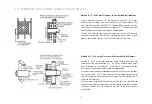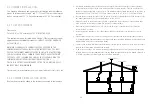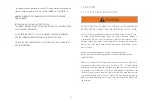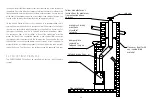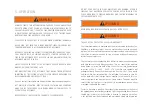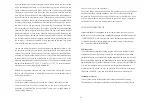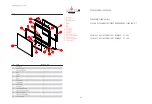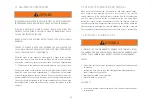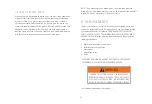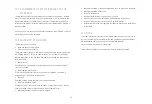
42
(2x4 size pieces). Lay the pieces lengthwise from side to side in the hot coal bed
with a shallow trench between, so that the primary air can flow directly into this
trench and ignite the fuel above. When the fire seems to be at its peak, medium
sized logs may be added. Once these logs have caught fire, carefully close the
door. (Closing the door too quickly after refuelling will reduce the firebox tempera-
ture and result in an unsatisfactory burn.) Remember it is more efficient to burn
medium sized wood, briskly, and refuel frequently than to load the appliance with
large logs that result in a smouldering, inefficient fire and dirty glass. As soon as
the door is closed, you will observe a change in the flame pattern. The flames
will get smaller and lazier because less oxygen is getting into the combustion
chamber. The flames, however, are more efficient. The flames will remain lazy but
become larger again as soon as the firebricks have been heated thoroughly and
the chimney becomes heated and provides a good draft. At this point, the roaring
fire that you see when the door is opened is wastefully drawing heated room air up
the chimney -- certainly not desirable. Always operate with the door fully closed
once the medium sized logs have caught fire.
You can now add larger pieces of wood and operate the appliance normally. Once
the appliance is entirely hot, it will burn very efficiently with little smoke from the
chimney. There will be a bed of orange coals in the firebox and secondary flames
flickering just below the top firebrick. You can safely fill the firebox with wood up
to the air inlet on the backside of the firebox or, if not present, up to 50% of the
fireboxes backside height and will get best burns if you keep the appliance pipe
temperatures between 250°F (120°C ) and 450°F (270°C ). A surface thermom-
eter placed on the front top will help regulate this.
Without an appliance thermometer, you are working blindly and have no
idea of how the appliance is operating! An appliance thermometer offers a
guide to performance.
Can’t get the fire going?
Use more kindling and paper. Assuming the chimney and vent are sized
correctly and there is sufficient combustion air, the lack of sufficiently dry
quantities of small kindling is the problem. Thumb size is a good gauge for
small kindling diameter.
Can’t get heat out of the appliance?
One of two things may have happened. The appliance door may have been
closed prematurely and the appliance itself has not reached optimum
temperature. Reopen the door and/or draft control to re-establish a brisk
fire. The other problem may have been wet wood. The typical symptom is
sizzling wood and moisture being driven from the wood.
ADJUSTING THE COMBUSTION AIR.
Spartherm Modules are equipped with an air control System that is easy and ef-
fective to use.The air control system is designed to give you the ability to adjust the
“COMBSUTION AIR” in such a way that you have a fire that burns clean and well.
It is important to ensure that the combustion air used to create a clean burning
fire… as per the following INFORMATION.
Air Wash system:
This combustion air is designed to keep the glass clean and to feed the fire with
combustion air to burn. The further the lever is to the right the more air is made
available for the fire. As an example this setting would be used when you first light
the fire or when you reload the fire. Depending on the type of fire that you require
you would adjust the air to either slow down the fire – moving to the right-MIDWAY. –
or to slow the fire even more as you move to the left past the midway mark.
It is important not to “choke” the fire – do not starve the fire of air as it can create
smoke and a dirty burn. It can also result in dirty glass and an inefficient fire.
Secondary Air system:
This air is used to burn off the gasses that are released when the fire burns.
The secondary air is also linked to the lever and is adjusted as you adjust the fire.
Summary of Contents for M 700 INSERT
Page 40: ...40...
Page 56: ...56 10 6 FOR YOUR INFORMATION...
Page 57: ...57 10 6 FOR YOUR INFORMATION...
Page 58: ...58 10 6 FOR YOUR INFORMATION...

